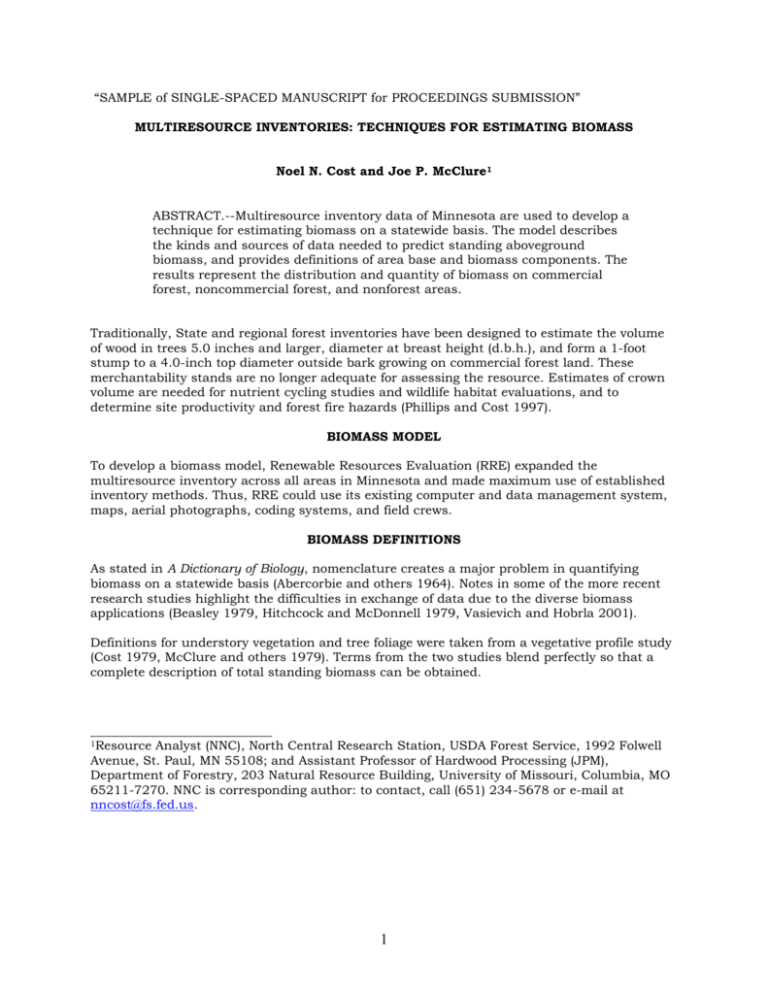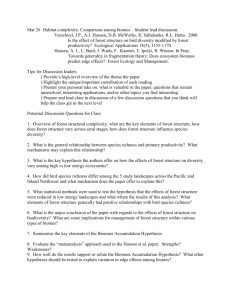Total Biomass - Forest Inventory and Analysis
advertisement

“SAMPLE of SINGLE-SPACED MANUSCRIPT for PROCEEDINGS SUBMISSION” MULTIRESOURCE INVENTORIES: TECHNIQUES FOR ESTIMATING BIOMASS Noel N. Cost and Joe P. McClure1 ABSTRACT.--Multiresource inventory data of Minnesota are used to develop a technique for estimating biomass on a statewide basis. The model describes the kinds and sources of data needed to predict standing aboveground biomass, and provides definitions of area base and biomass components. The results represent the distribution and quantity of biomass on commercial forest, noncommercial forest, and nonforest areas. Traditionally, State and regional forest inventories have been designed to estimate the volume of wood in trees 5.0 inches and larger, diameter at breast height (d.b.h.), and form a 1-foot stump to a 4.0-inch top diameter outside bark growing on commercial forest land. These merchantability stands are no longer adequate for assessing the resource. Estimates of crown volume are needed for nutrient cycling studies and wildlife habitat evaluations, and to determine site productivity and forest fire hazards (Phillips and Cost 1997). BIOMASS MODEL To develop a biomass model, Renewable Resources Evaluation (RRE) expanded the multiresource inventory across all areas in Minnesota and made maximum use of established inventory methods. Thus, RRE could use its existing computer and data management system, maps, aerial photographs, coding systems, and field crews. BIOMASS DEFINITIONS As stated in A Dictionary of Biology, nomenclature creates a major problem in quantifying biomass on a statewide basis (Abercorbie and others 1964). Notes in some of the more recent research studies highlight the difficulties in exchange of data due to the diverse biomass applications (Beasley 1979, Hitchcock and McDonnell 1979, Vasievich and Hobrla 2001). Definitions for understory vegetation and tree foliage were taken from a vegetative profile study (Cost 1979, McClure and others 1979). Terms from the two studies blend perfectly so that a complete description of total standing biomass can be obtained. _____________________________ 1Resource Analyst (NNC), North Central Research Station, USDA Forest Service, 1992 Folwell Avenue, St. Paul, MN 55108; and Assistant Professor of Hardwood Processing (JPM), Department of Forestry, 203 Natural Resource Building, University of Missouri, Columbia, MO 65211-7270. NNC is corresponding author: to contact, call (651) 234-5678 or e-mail at nncost@fs.fed.us. 1 Forest Land Commercial Forest Land Forest land at least 1 acre in size and producing, or capable of producing, crops of industrial wood and not withdrawn from timber utilization. Unproductive Forest Land Forest land is capable of producing 20 cubic feet per acre of industrial wood under natural conditions because of adverse site conditions. Unproductive forest land can be highly productive for wildlife management (Adams 1947, Sampson 1980, Bull 1981). Total Biomass The 37.4 million acres of commercial forest, noncommercial forest, and nonforest in Florida support over 2.5 trillion pounds of green biomass. Of the 2.5 trillion pounds of biomass, 74 percent is in wood and bark, 8 percent is in tree foliage, and 18 percent is in other vegetation. The percentage of biomass supported by commercial forest, noncommercial forest, and nonforest uses is shown in Figure 1. The quantity of biomass in each broad use category is highly dependent upon the acreage within the State as well as the concentration of material on these acres (Fig. 1). In interpreting biomass quantities, therefore, it is helpful to know how many acres are in each category. Species Groups Table 1 shows the distribution of wood and bark associated with nonforest use, by selected species groups. Eastern white pine (Pinus strobus L.) is the leading pine and contains over half of the pine biomass. Twenty-nine percent of the nonforest area consists of marsh and water, 21 percent improved pasture, 17 percent urban and other, 16 percent cropland, 13 percent rangeland, 3 percent idle farmland, and 1 percent other farmland (Table 2). ACKNOWLEDGMENT The authors thank the Department of Agriculture and Consumer Services, Division of Forestry, St. Paul, MN, for their cooperation. This research, in part, was supported by the Missouri Agricultural Experiment Station project number RJVA99-02. The authors also acknowledge the assistance of two anonymous reviewers whose suggestions greatly improved the manuscript. This is contribution 2002-09 from the Missouri Agricultural Experiment Station. LITERATURE CITED Abercrobie, M.; Hickman, C.J.; Johnson, M.L. 1964. A dictionary of biology. Chicago, IL: Aldine Publishing Co. 798 p. (Book or monograph) Adams, L. 1947. Food habit of cow birds in relation to reforestation. Journal of Wildlife Management. 11(3): 281-282. (Journal or periodical article) Beasley, R.S. 1979. Assessment of non-point source from forest practices. In: Research needs and problems in assessing impact of forest management practices on water quality and utility. Tech. Bull. 328. New York, NY: National Council for Air and Stream Improvement: 10-13. (Chapter in book that is part of a series) 2 Bull, E.L. 1981. Indirect estimates of abundance of birds. Estimating numbers of terrestrial birds: Proceedings, international symposium; 1980 October 26-31; Asilomar, CA. In: Studies in Avian Biology. Cooper Ornithological Society. 6: 76-80. (Article in proceedings published in journal) Burns, R.M.; Honkala, B.H., tech. coord. 1999. Silvics of North America. Volume 2, Hardwoods. Agric. Handbk. 654. Washington, DC: U.S. Department of Agriculture, Forest Service. Xxx p. (Book in series with editors) Cost, N.D. 1979. Ecological structure of forest vegetation. In: Forest resource inventories; 1979 July 22-27; Fort Collins, CO: 29-37. (Proceedings article, unidentified publisher) Hitchcock, H.C., III; McDonnell, J.P. 1980. Provisional forest biomass statistics for the 201county Tennessee valley region. Tech. Note B38. Norris, TN: Tennessee Valley Authority. 8 p. (Series) McClure, J.P.; Cost, N.D.; Knight, H.A. 1979. Multiresource inventories—a new concept for forest survey. Res. Pap. SE-191. Asheville, NC: U.S. Department of Agriculture, Forest Service, Southeastern Research Station. 68 p. (Series) Phillips, D.R.; Cost, N.D. 1997. Estimating the volume of hardwood crowns, stems, and the total tree. In: Pallardy, S.G.; Cecich, R.A.; Garrett, H.G.; Johnson, P.S., eds. Proceedings, 11th Central Hardwood forest conference; 1997 March 23-26; Columbia, MO. Gen. Tech. Rep. NC188. St. Paul, MN: U.S. Department of Agriculture, Forest Service, North Central Forest Experiment Station: 198-215. (Proceedings with proceedings editors) Sampson, D., Jr. 1980. Game bird distribution in upland oak savannas. Columbia, MO: University of Missouri. 88 p. Ph.D. dissertation. (Thesis or dissertation) Vasievich, J.M; Hobrla, S.L. 2001. Great Lakes ecological assessment.. St. Paul, MN: U.S. Department of Agriculture, Forest Service, North Central Research Station. Available: http://www.ncrs.fs.fed.us/epubs/index.html. (Accessed May 8, 2011.) (On line publication) Figure Captions Figure 1.—Percentage of all forest holdings by size of landowner and forest tract in Minnesota. 3







